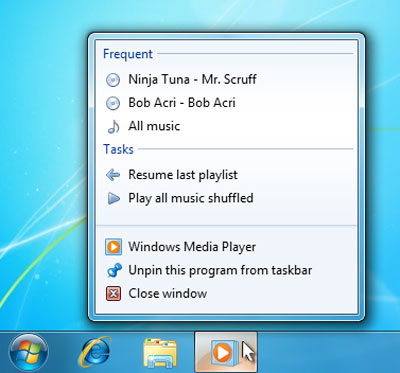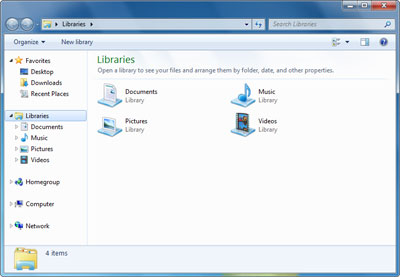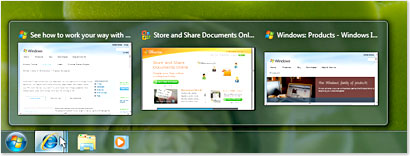|
|
||||
Microsoft describes the Windows 7 experience as "Your PC, simplified," and that's true to a certain extent. It takes the basic interface from the much maligned Vista (though I liked it) and builds on that with some enhancements. And it does put things more closely at hand than before, with more flexibility, so that's good.
Microsoft says the OS is also faster starting up, shutting down and resuming from sleep. I didn't time it, but it does seem faster. Fast enough, anyway.
I've always done clean installs every time I changed operating systems, so this time I thought I'd try going the upgrade route, which installs the new OS over top of the old one, kind of, keeping all of the associations to your existing programs. This is the easiest way to do it – you don't have to go back and reinstall all your software again from scratch – though I've also heard it isn't as good because it brings along all the crap that's built up in your Windows Registry over time.
I don't know if that's true or not, but my upgrade install went fine. The process itself is easy as pie; the most difficult thing is typing in that darn product key! In fact, I pretty well started the process and then walked away. When I came back the networking was all set up for me and everything was ready to go.
Windows 7 worked well, too, stable and quick, from the upgrade install.
 As luck would have it, I also had the opportunity to do a clean install. The chance came when my PC was attacked by some spyware, the first time that has ever happened to me. Whatever hit was particularly vicious: anytime I tried to do anything I'd get a popup window warning me about a problem and asking if I want to scan the system. If I pressed "okay" I'd be whisked to some site purporting to offer antivirus protection and if I pressed "cancel" I'd be up the creek, looking at a pop up that wasn't going anyway. I nearly put my fist through my monitor.
As luck would have it, I also had the opportunity to do a clean install. The chance came when my PC was attacked by some spyware, the first time that has ever happened to me. Whatever hit was particularly vicious: anytime I tried to do anything I'd get a popup window warning me about a problem and asking if I want to scan the system. If I pressed "okay" I'd be whisked to some site purporting to offer antivirus protection and if I pressed "cancel" I'd be up the creek, looking at a pop up that wasn't going anyway. I nearly put my fist through my monitor.
I hope whoever inflicted that little marketing scheme on me goes straight to Hell, quickly!
Anyway, as I wasn't about to knuckle under to extortion, I shut the system down, reformatted the drive and went back to Square One, with the fresh install. It also went well, though of course it meant I had to reinstall everything else I use as well, which is a major ordeal. Such is life.
The first thing I noticed after the installs is that 7 looks very much like Vista and to me that's a good thing. Perhaps you could call it Vista 2.0, because it goes beyond Vista in some neat ways.
One of the things they've kept from Vista is the Windows Explorer interface, which lets you navigate folders quickly by clicking on arrows that display the entire tree from which a particular folder stems (no pun intended; well, maybe). This was one of the things I loved most about Vista because it speeds up the process of moving around through your folders a lot, as well as making it easier to keep track of where your stuff is.
The Start menu has been redesigned as well and eliminates the "Recent" file list choice – though you can bring it back if you want. In its place, the icons for the programs in the Start menu have their own recently-used file list, which gives you more "memories" than before and organizes them by their associated software application. That's another handy bit of flexibility.
 Not only that, but if you right click on the icons of the programs on the taskbar, you also get a list of the files used recently in each app. You can drag the taskbar icons around, putting them wherever you please, and to differentiate between apps that are running and one that are merely residing on the taskbar, active apps are highlighted. Not only that, but put your cursor over a highlighted taskbar icon and you get little previews of the files open in the app; click on the one you want quick access to and that particular window pops up. It's pretty slick, and very handy.
Not only that, but if you right click on the icons of the programs on the taskbar, you also get a list of the files used recently in each app. You can drag the taskbar icons around, putting them wherever you please, and to differentiate between apps that are running and one that are merely residing on the taskbar, active apps are highlighted. Not only that, but put your cursor over a highlighted taskbar icon and you get little previews of the files open in the app; click on the one you want quick access to and that particular window pops up. It's pretty slick, and very handy.
Manipulating windows can be pretty cool, too. For example, if you kind of ram a window into the edge of your monitor screen it'll change shape to take up half the screen. Do this with two windows and you have a nice, easy way to compare them side by side. Jam a window to the top of the screen and it maximizes.
The left hand pane of the Windows Explorer, er, windows, now offers two ways to get at your stuff. Call Libraries and HomeGroups, the former gives you quick access to Documents, Music, Pictures, and Videos, and you can customize them to point at where you really want them to. For example, I like keeping "My Documents" on an external, 1 Terabyte drive instead of on C: where Bill Gates and his merry band wants me to. Windows 7 let me add my own file location to the libraries so it comes up in the "documents" pane instead of me having to point and click my way over to the right drive and right folder all the time.
Homegroups are meant to make it easier to network your Windows 7 PC's, granting each other read and write access to their libraries and folders, stream media and share peripherals. I haven't tried this, but I like the sound of it.
 I still have some software incompatibilities with Windows 7 64 bit, the same way I had with Vista, but most of my apps run fine. The problems I've found are with older programs, such as my ancient versions of The Print Shop and Audio Cleaning Lab (both of which have new, Windows 7 versions available that I'll be reviewing soon). They simply refuse to run and are annoyingly stubborn about it. Fortunately most of my apps are newer or newest versions and they haven't given me any trouble.
I still have some software incompatibilities with Windows 7 64 bit, the same way I had with Vista, but most of my apps run fine. The problems I've found are with older programs, such as my ancient versions of The Print Shop and Audio Cleaning Lab (both of which have new, Windows 7 versions available that I'll be reviewing soon). They simply refuse to run and are annoyingly stubborn about it. Fortunately most of my apps are newer or newest versions and they haven't given me any trouble.
One thing I hate is the latest version of Internet Explorer, version 8. I don't like IE anyway, but some sites only function correctly if you use it – how's that for user friendly web design? – which means that you're forced to crank it up sometimes whether you want to or not. Alas, this current version is unstable and crashes often on some websites. It usually starts itself back up, fortunately, which is nice, but it shouldn't have to.
On the other hand, IE can now reopen your last browsing session, something Mozilla Firefox has done for a while, and that's a nice feature after a crash – or when you aren't paying attention and shut down the entire app instead of just closing particular tabs.
Windows Vista took a lot of flack for being bloated and unstable, making people pine for XP. I didn't have a lot of problems with it, but I like Windows 7 better anyway. Overall, it seems quite stable and pleasant to use and I haven't experienced any problems worth whining about.
So far, so good.
Copyright 2010 Jim Bray
TechnoFile.com
Jim Bray's columns are available through the TechnoFile Syndicate.
 Windows 7, the First Months – So far, So Good
Windows 7, the First Months – So far, So Good